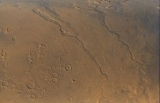
Niger Vallis
Encyclopedia
Niger Vallis is a valley on Mars
that appears to have been carved by water. It has been identified as an outflow channel. It merges with Dao Vallis
which runs southwestward into Hellas Planitia
from the volcanic Hadriacus Mons. Like Dao, it was formed around the Late Noachian and Early Hesperian Epochs. It is named after the Niger River
in Africa
.
.
Changes in Mars's orbit and tilt cause significant changes in the distribution of water ice from polar regions down to latitudes equivalent to Texas. During certain climate periods water vapor leaves polar ice and enters the atmosphere. The water comes back to ground at lower latitudes as deposits of frost or snow mixed generously with dust. The atmosphere of Mars contains a great deal of fine dust particles. Water vapor will condense on the particles, then fall down to the ground due to the additional weight of the water coating. When ice at the top of the mantling layer goes back into the atmosphere, it leaves behind dust, which insulating the remaining ice.
Mars
Mars is the fourth planet from the Sun in the Solar System. The planet is named after the Roman god of war, Mars. It is often described as the "Red Planet", as the iron oxide prevalent on its surface gives it a reddish appearance...
that appears to have been carved by water. It has been identified as an outflow channel. It merges with Dao Vallis
Dao Vallis
Dao Vallis is a valley on Mars that appears to have been carved by water. It runs southwestward into Hellas Planitia, and has been identified as an outflow channel. It and its tributary, Niger Vallis, extend for about 1200 km. It is named after the Thai word for star...
which runs southwestward into Hellas Planitia
Hellas Planitia
Hellas Planitia, also known as the Hellas Impact Basin, is a huge, roughly circular impact basin located in the southern hemisphere of the planet Mars. It is the second or third largest impact crater and the largest visible impact crater known in the Solar System...
from the volcanic Hadriacus Mons. Like Dao, it was formed around the Late Noachian and Early Hesperian Epochs. It is named after the Niger River
Niger River
The Niger River is the principal river of western Africa, extending about . Its drainage basin is in area. Its source is in the Guinea Highlands in southeastern Guinea...
in Africa
Africa
Africa is the world's second largest and second most populous continent, after Asia. At about 30.2 million km² including adjacent islands, it covers 6% of the Earth's total surface area and 20.4% of the total land area...
.
Ice-rich Mantle
Much of the surface of Mars is covered by a thick smooth mantle that is thought to be a mixture of ice and dust. This ice-rich mantle, a few yards thick, smoothes the land, but in places it has a bumpy texture, resembling the surface of a basketball. Because there are few craters on this mantle, the mantle is relatively young. An image below shows a good view of this smooth mantle around Niger Vallis, as observed with HiRISEHiRISE
High Resolution Imaging Science Experiment is a camera on board the Mars Reconnaissance Orbiter. The 65 kg , $40 million instrument was built under the direction of the University of Arizona's Lunar and Planetary Laboratory by Ball Aerospace & Technologies Corp....
.
Changes in Mars's orbit and tilt cause significant changes in the distribution of water ice from polar regions down to latitudes equivalent to Texas. During certain climate periods water vapor leaves polar ice and enters the atmosphere. The water comes back to ground at lower latitudes as deposits of frost or snow mixed generously with dust. The atmosphere of Mars contains a great deal of fine dust particles. Water vapor will condense on the particles, then fall down to the ground due to the additional weight of the water coating. When ice at the top of the mantling layer goes back into the atmosphere, it leaves behind dust, which insulating the remaining ice.

